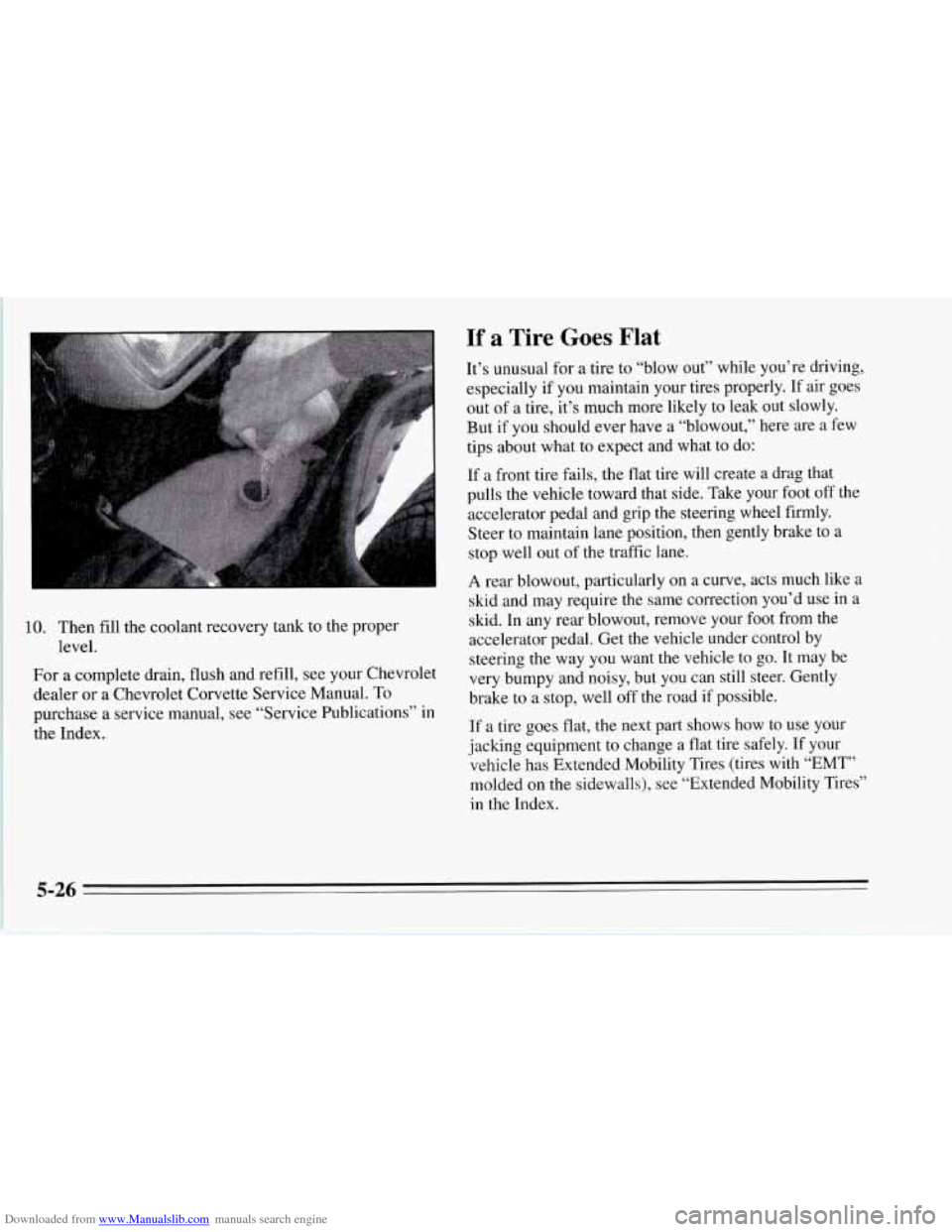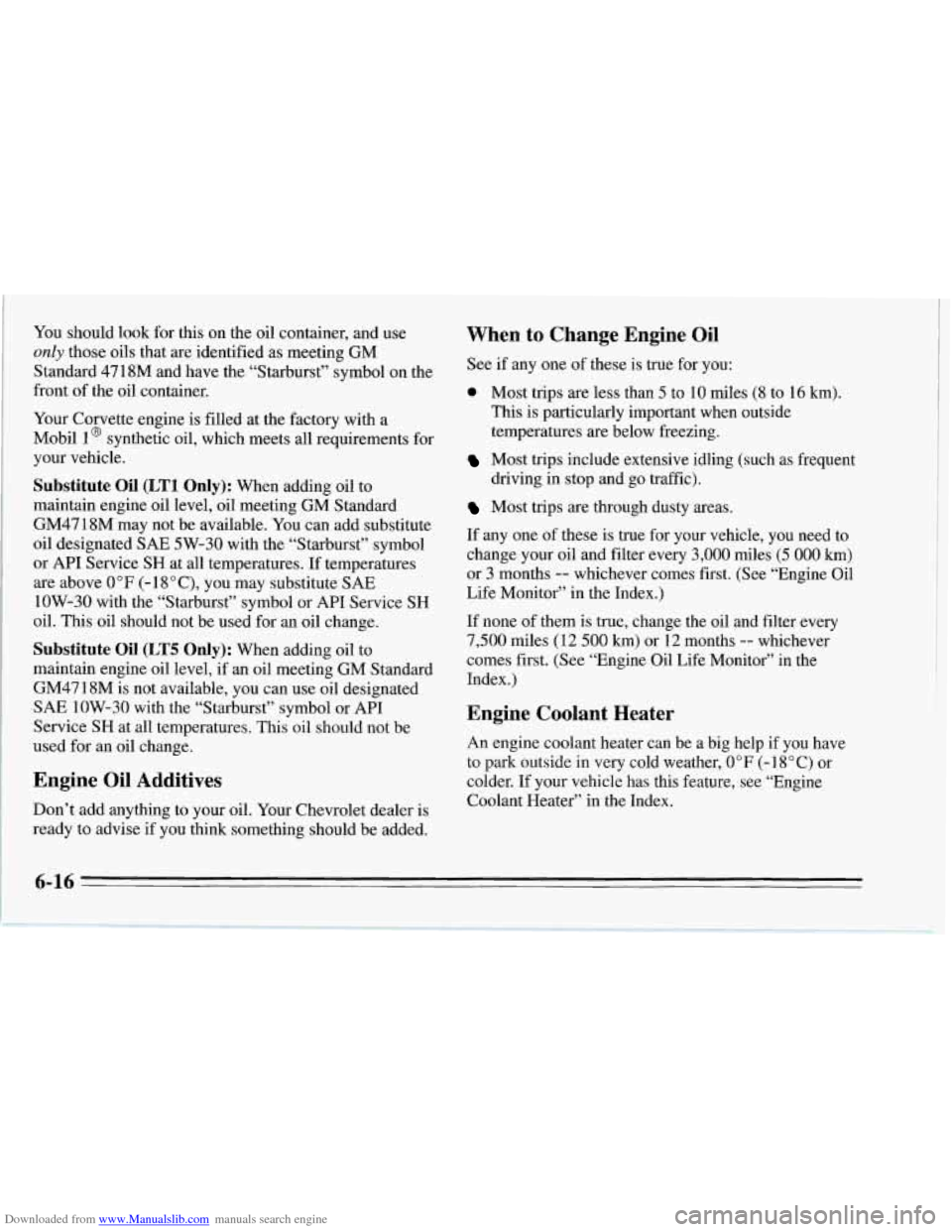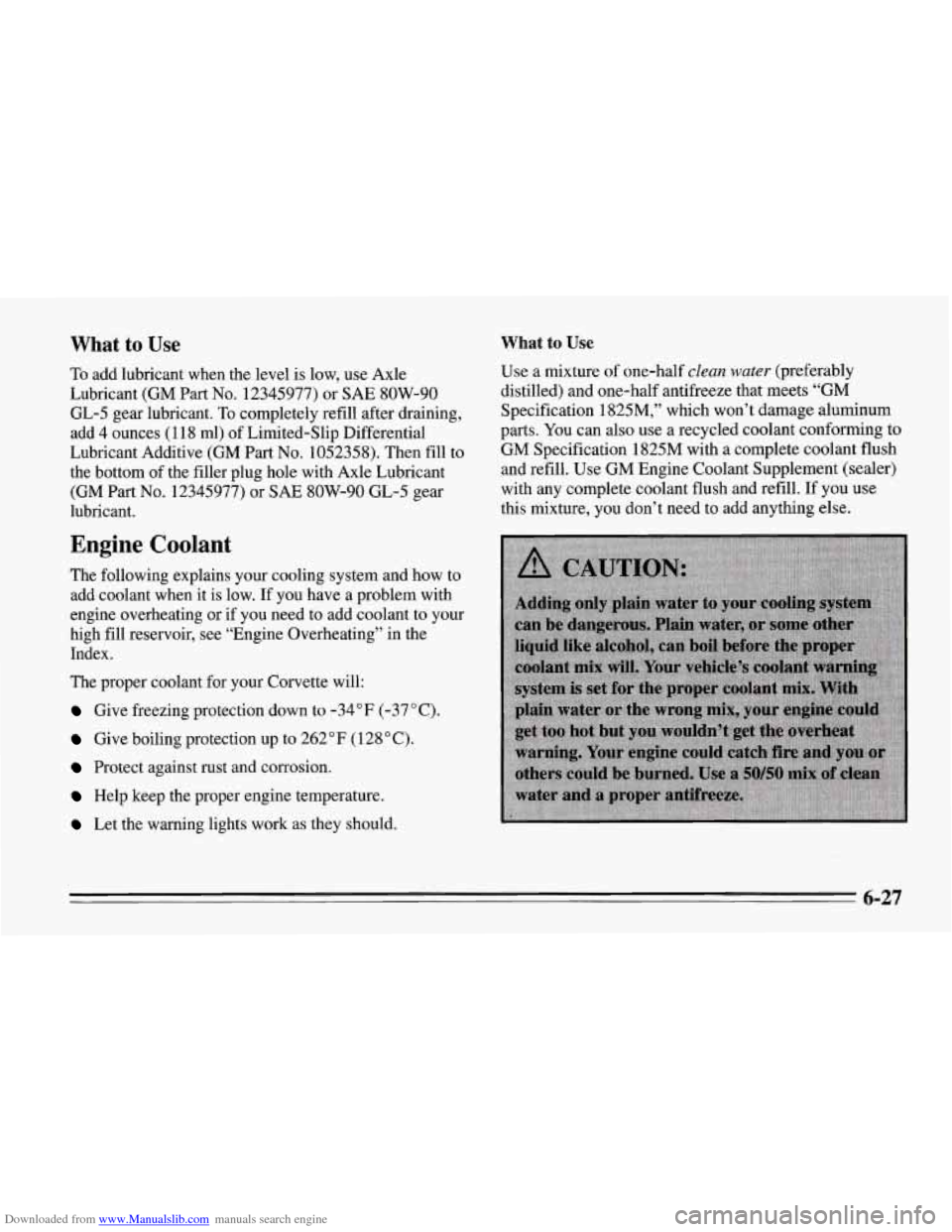Page 217 of 386
Downloaded from www.Manualslib.com manuals search engine 1. You can remove the coolant high fill reservoir
pressure cap when the cooling system, including the
coolant high fill reservoir pressure cap and upper
radiator hose, is no longer hot. Turn the pressure cap
slowly to the left until it first stops. (Don’t press
down while turning the pressure cap.)
If
you hear a hiss, wait for that to stop. A hiss means
there
is still some pressure left.
2.. Then keep turning the pressure cap, but now push
down as you turn it. Remove the pressure cap. 3. After the engine cools, open the air bleed valve on
the water pump inlet.
5-24
Page 218 of 386
Downloaded from www.Manualslib.com manuals search engine 4. Fill with the proper mix. Add coolant until you see a
steady stream of coolant coming from the bleed
valve.
5. Close the bleed valve.
6. Continue to fill the coolant high fill reservoir up to
the base of the filler neck.
7. Rinse or wipe the spilled coolant from the engine
and compartment.
8. Start the engine and allow it to run in idle for
approximately four minutes.
By this time, the
coolant level inside the coolant high fill reservoir
will be lower. Add more
of the proper mix through
the filler neck
until the level reaches the base of the
filler neck.
9. Shut the engine off and replace the pressure cap. Be
sure the arrows
on the cap line up like this.
5-25
Page 219 of 386

Downloaded from www.Manualslib.com manuals search engine 10. Then fill the coolant recovery tank
level. to the proper
For a complete drain, flush and refill, see your Chevrolet
dealer
or a Chevrolet Corvette Service Manual. To
purchase a service manual, see “Service Publications” in
the Index.
If a Tire Goes Flat
It’s unusual for a tire to “blow out” while you’re driving,
especially if you maintain your tires properly. If air goes
out of a tire, it’s much more likely to leak out slowly.
But if you should ever have
a “blowout,” here are a few
tips about what to expect and what
to do:
If a front tire fails, the flat tire will create a drag that
pulls the vehicle toward that side. Take your foot off the
accelerator pedal and grip the steering wheel firmly.
Steer to maintain lane position, then gently brake to a
stop well out of the traffic lane.
A rear blowout, particularly on a curve, acts much like a
skid and may require the same correction you’d use in a
skid. In any rear blowout, remove your foot from the
accelerator pedal. Get the vehicle under control by
steering the way you want the vehicle to
go. It may be
very bumpy and noisy, but you can still steer. Gently
brake to a stop, well off the road if possible.
If a tire goes flat, the next part shows how to use your
jacking equipment to change a flat tire safely. If your
vehicle has Extended Mobility Tires (tires with “EMT”
molded on the sidewalls), see “Extended Mobility Tires”
in the Index.
5-26
Page 244 of 386
Downloaded from www.Manualslib.com manuals search engine You’ll see the following when you open the hood with
the
LTl engine:
1.
2.
3.
4.
5.
6.
7.
8.
9.
10.
11.
12.
Hydraulic Clutch Fluid Reservoir (if equipped)
Brake Fluid Reservoir
Battery
Electric Engine Fan
Air Cleaner
Coolant Recovery Tank Power Steering Fluid Reservoir
Engine Oil Fill Cap
Engine Oil Dipstick Windshield Washer Fluid Reservoir
Coolant High
Fill Reservoir
Automatic Transmission Dipstick (if equipped)
6-9
Page 246 of 386
Downloaded from www.Manualslib.com manuals search engine 5.
6.
7.
8.
9.
10.
11.
Air Cleaner Coolant Recovery Tank
Power Steering Fluid Reservoir
Engine Oil Fill Cap
Engine Oil Dipstick
Windshield Washer Fluid Reservoir
Coolant High Fill Reservoir
Then release the hood strut by moving it
to the centered
position and lowering the hood. Lower the hood until
the bottom of the hood is the same height as the top of
the windshield, then release it.
Before closing the hood, be sure all the filler caps are
on,
6-11
Page 251 of 386

Downloaded from www.Manualslib.com manuals search engine You should look for this on the oil container, and use
only those oils that are identified as meeting GM
Standard
4718M and have the “Starburst” symbol on the
front of the oil container.
Your Corvette engine is filled at the factory with a
Mobil
1 @ synthetic oil, which meets all requirements for
your vehicle.
Substitute Oil (LTl Only): When adding oil to
maintain engine oil level, oil meeting GM Standard
GM47
18M may not be available. You can add substitute
oil designated
SAE 5W-30 with the “Starburst” symbol
or API Service SH at all temperatures. If temperatures
are above
0” F (- 18 O C), you may substitute SAE
1OW-30 with the “Starburst” symbol or API Service
SH
oil. This oil should not be used for an oil change.
Substitute Oil (LT5 Only): When adding oil to
maintain engine oil level,
if an oil meeting GM Standard
GM47
18M is not available, you can use oil designated
SAE 1OW-30 with the “Starburst” symbol or API
~ Service SH at all temperatures. This oil should not be
used for
an oil change.
Engine Oil Additives
Don’t add anything to your oil. Your Chevrolet dealer is
ready to advise if you think something should be added.
When to Change Engine Oil
See if any one of these is true for you:
0 Most trips are less than 5 to 10 miles (8 to 16 km).
This is particularly important when outside
temperatures are below freezing.
Most trips include extensive idling (such as frequent
driving in stop and
go traffic).
Most trips are through dusty areas.
If any one of these is true for your vehicle, you need to
change your oil and filter every 3,000 miles
(5 000 km)
or 3 months -- whichever comes first. (See “Engine Oil
Life Monitor” in the Index.)
If none of them is true, change the oil and filter every
7,500 miles (12 500 km) or 12 months -- whichever
comes first. (See “Engine Oil Life Monitor” in the
Index.)
Engine Coolant Heater
An engine coolant heater can be a big help if you have
to
park outside in very cold weather, 0” F (- 1 8 O C) or
colder. If your vehicle has this feature, see “Engine
Coolant Heater” in the Index.
6-16
Page 262 of 386

Downloaded from www.Manualslib.com manuals search engine What to Use What to Use
To add lubricant when the level is low, use Axle
Lubricant (GM Part
No. 12345977) or SAE SOW-90
GL-5 gear lubricant.
To completely refill after draining,
add
4 ounces (1 18 ml) of Limited-Slip Differential
Lubricant Additive (GM Part
No. 1052358). Then fill to
the bottom of the filler plug hole with Axle Lubricant
(GM Part
No. 12345977) or SAE 8OW-90 GL-5 gear
lubricant.
Engine Coolant
The following explains your cooling system and how to
add coolant when it is low.
If you have a problem with
engine overheating or if you need to add coolant to your
high fill reservoir, see “Engine Overheating” in the
Index.
The proper coolant for your Corvette will:
Give freezing protection down to -34°F (-37°C).
Give boiling protection up to 262 “F (128 ” C).
Protect against rust and corrosion.
Help keep the proper engine temperature.
Let the warning lights work as they should. Use a mixture
of one-half
clean water (preferably
distilled) and one-half antifreeze that meets
“GM
Specification 1825M,” which won’t damage aluminum
parts.
You can also use a recycled coolant conforming to
GM Specification 1825M with a complete coolant flush
and refill. Use GM Engine Coolant Supplement (sealer)
with any complete coolant flush and refill. If
you use
this mixture, you don’t need to add anything else.
6-27
Page 263 of 386
Downloaded from www.Manualslib.com manuals search engine NOTICE:
If you use an improper coolant mix, your engine
could overheat and be badly damaged. The
repair cost wouldn’t be covered by your
warranty.
Too much water in the mix can freeze
and crack the engine, radiator, heater core and other parts.
Adding Coolant
To Check Coolant
When your engine is cold, check the dipstick on the cap
of the coolant recovery tank. The coolant level should
be at COLD, or a little higher. When your engine is
warm, the level on the dipstick should be up to the HOT,
or a little higher. Your
Corvette also has
a high fill reservoir located at the
right rear of the engine compartment.
If the recovery tank
is very low or empty, also add
coolant to the
high fill reservoir. To add coolant at the
high fill reservoir, see “Engine Overheating” in the
Index.
6-28